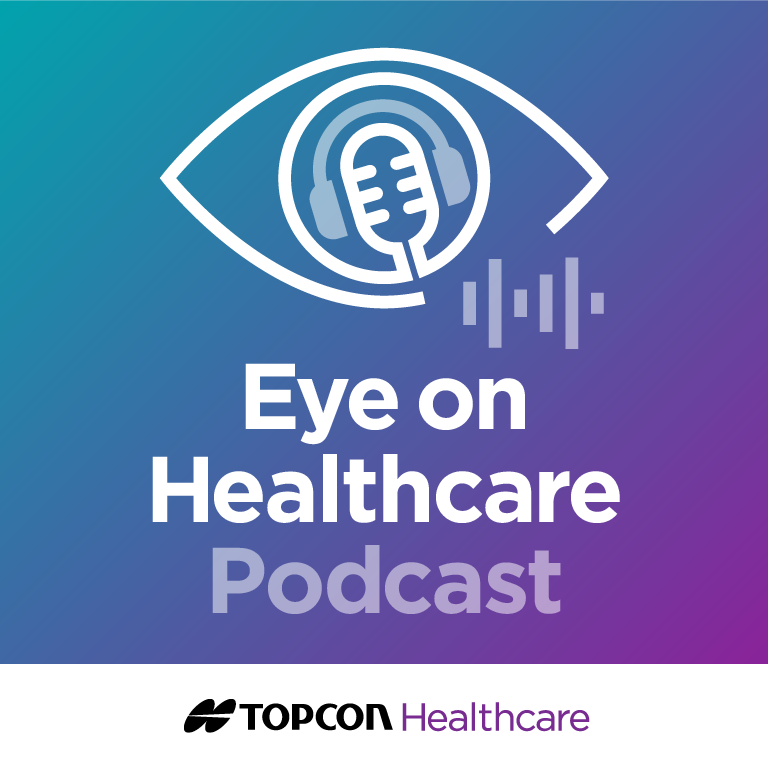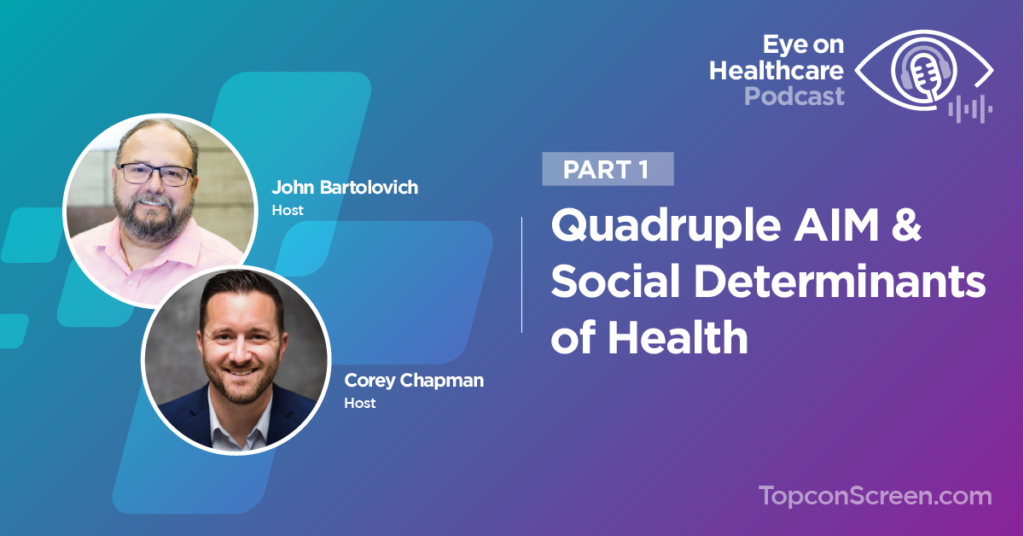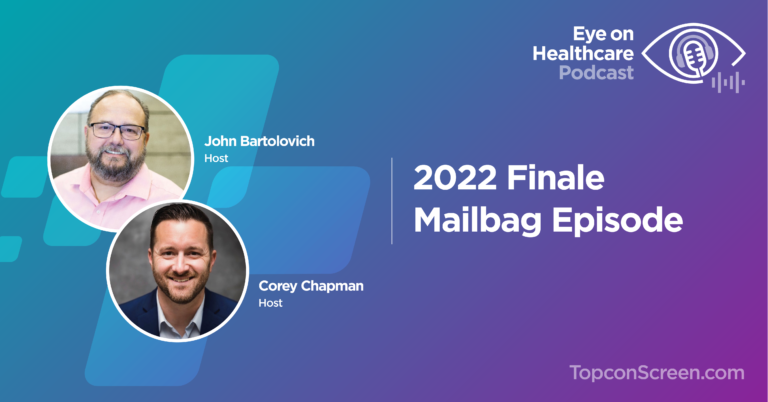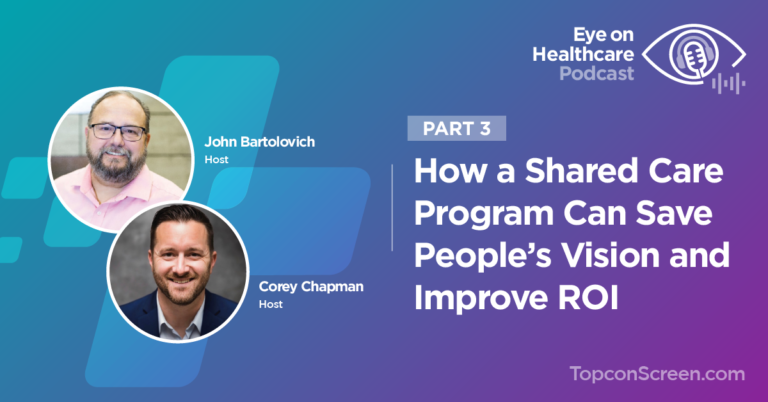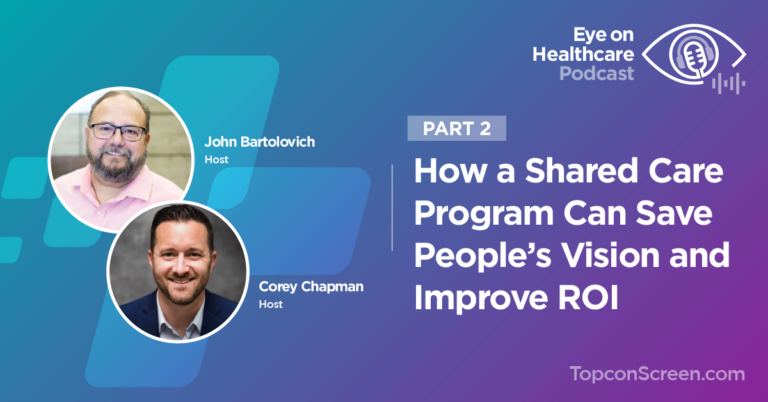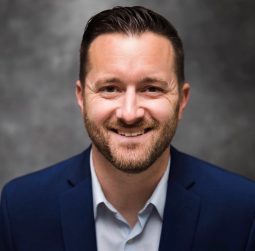Episode Transcript
Corey: Welcome back to the Eye on Healthcare podcast. Your weekly dose of all things Topcon Screen and maybe not all things Topcon Screen, all things health economics. John, help me here. I’m sinking.
John: I think it’s a combination of health, economics, population health. We’re comfortable taking on a broad range of topics
Corey: Well put. I’ll put that in the summary of the show. Excellent. Welcome back, John. Great to have you hosting again. Tell me. Why we’re doing this episode?
John: Yeah, I. It’s interesting. We participated in a webinar as a company and one of our customers was actually the participant. And it was very interesting to me that we talked about the triple AIM healthcare and the quadruple AIM healthcare and population health and social determinants of health. But there were a couple key points during that webinar that really struck me and one of them was when the doctor said this exam meets all four of the quadruple aims of healthcare. And I said maybe that’s something we could talk about on a pod podcast.
Corey: You’re always thinking, John, I love it. I love it. OK, so for those who don’t know, what is the quadruple AIM
John: Probably need to go back and look at how it began and really in 2007, the Institute for Healthcare Improvement launched an initiative called the triple AIM and it was really focused on three key areas. One is improving the patient experience with healthcare. Two, improving population health and in, you know, chronic disease in the Community as a whole and then lastly reducing the per capita costs associated with healthcare. All things that really fall in line with value-based care and value-based initiatives, but as they got going, one thing they noticed was very quickly that there was a major shortcoming to that and that was physician burnout. There are a lot of reasons for physician burnout that we’re probably not going to get into here, but what they noticed was that physician burnout was having the exact opposite effect of what they originally intended for the triple aim of healthcare. So, in 2014 they added the provider wellbeing as the fourth AIM, so we now have the quadruple AIM
Corey: Alright. And so, was that the addition of the physician burnout, was that feedback from the doctors that said, you know, this is something that we should keep in a consideration or how did that work?
John: Yes, it was a combination of you know, discussions with physicians, physician surveys looking at wellbeing and practice management in really there were, you know at the time it was, I believe the study said it was roughly 40% of physicians were considering leaving practice at the time.
Corey: Wow. OK, that’s huge. OK, good idea to lump that in then for sure.
John: So, you know, after hearing that discussion. It became more of a matter of OK, so. Topcon Screen, what do we do? We take a very important test, Diabetic retinopathy exam, and we have that done at point of care for a variety of reasons. So let let’s look at the first aim of the quadruple aim. Well, the four aims are patient experience, population health, cost reduction, and provider well-being. So, when we look at that the first aim it’s really about valuing the patient, making the patient the center of everything that healthcare is doing and delivering high quality, high value care to these patients. A lot of different things come into play, improved access, reduced wait times. So, one of the ways Topcon Screen impacts that, Corey, is by bringing the diabetic eye exam into the point of care test in the primary care physicians office, we’re reducing a lot of things for the patient: multiple visits, they’re not having to go across town or in some instances 40 minutes away to go see a specialist. So, they have less travel time. They need less childcare to go to doctors’ appointments. They have fewer copays. The other key here is. This is bringing a high-quality exam to the patient where the patient is and you know in some areas, they may not have the ability to get to a special a specialist for a variety of reasons. So, this also impacts Health Equity so it’s really, I get how the doctor was referencing how this exam does impact on the patient experience because just by the eliminating some things and concerns for them, it’s going to elevate their happiness in their primary care physician, if you will.
Corey: Can I just add on a personal level? I had never been a part of, or at least were cognizant of patient surveys before with doctors’ offices and about four or five years ago my office did one and I you know, I slipped through it. I didn’t really pay too much attention to it. But I come to find out they had ended up moving about a year later into a new facility, new building. And one of the changes that occurred that actually came off of the survey that they sent out to everyone that I didn’t really help in, I guess, was the lab piece. So, in our old office, the lab was about 1/4 to 1/2 mile away. And you know, everybody needs blood work here and there. And when they moved into the new office. They built the lab right in so you could get your blood drawn right there. And I just remember going, oh, this is great. I don’t have to go somewhere else. And I’m, you know, not the guy that wouldn’t go somewhere else but it became almost a little bit of a talking point for me because it improved the satisfaction for me as a patient to say I could stay here. So, when you talk about being able to provide that eye exam at point of care, that’s what I think about it. And I kind of smile because I’m like, oh yeah, they, they, they were thinking about me and they made it a one stop shop for everything that I had to do. So, I just want to throw that in there.
John: Yeah, piggyback to you on that, you know, many managed care plans, the federal government in general, HEDIS in particular, are requiring patient satisfaction surveys. So, you know, anything that a practice could do to make life easier on the patient is going to bode well for them when it comes to these cap surveys.
Corey: Excellent.
John: So, you know the second aim comes around population health and in all the practices out there, you would really have to be living under a rock not to understand that there really is a transition moving from volume-based care and fee for service to value-based care. And you know, making sure that there’s an equity of access for all patients that you don’t have to be rich or have the top-of-the-line insurance to get standards of care. And also, the goal is to reduce the disease burden and yeah, this screening exam falls into this perfectly because, number one, we at Topcon Screen, focus with our clients on care gap closure. It’s one thing to say, yes, we have a large patient population of diabetics and we need to get this care, this exam done. But if we’re only focusing on 10% or 20% of those patients, we are really not closing that care gap and that’s where we really focus on. If a practice tells us they have 1000 diabetics and they want to hit 80%, we know that over the course of a year they have to do the exam on at 800 patients, so we help them to maintain their focus on closing that care gap in and getting to where they want to be. But more importantly, this also flows right into decreasing utilization and better chronic care management because the earlier we can catch this; we’ve talked up previous episodes that it can cost anywhere from $600 to $20,000 annually to treat moderate diabetic retinopathy and it could be an excess of millions if a patient goes blind. So, if we can catch these patients before there’s a severity of disease, we’re really having an impact on how the healthcare system is facing that diabetic eye disease burden and helping to control the costs associated with it. And then again, lastly, it’s you know again we’re powering that practice having the ability to deliver the right care to the patient at the right time. Patients see, diabetics in particular, they will go see their primary care physician at a minimum of four times a year. They may not ever go see a specialist.
Corey: Alright, so tell me a little bit about the third aim, reducing cost.
John: Well, this is probably the easiest one, so really the goal here is let’s what can we do to reduce the cost and service delivery. What can we do to reduce avoidable ER usage? What can we do to reduce hospital admissions and how can we really get a return on our cost invested in innovative ideas? So, Topcon Screen impacts in a couple different ways. Number one, by doing it at point of care there’s going to be fewer copays, the patient is not going to have to go see a specialist to have this exam done. They may need to go see a specialist if diseases are found, but they don’t need to go see a specialist just to have the exam done. We’re also lowering the utilization of high-cost tests and procedures. This is a $30 to $40 exam in the office and as we stated earlier in in this session, cost of treating mild to moderate diabetic retinopathy can be $600 to $20,000 annually, so that is a huge savings to health care in the health care system if we can catch this disease earlier and lower this utilization. Look at it this way. If a patient starts having vision issues or they go blind they’re going to be more prone to falls, and if they’re more prone to falls, they’re going to be more prone to going to the ER. They’re going to be more prone to hospital admission, they may fall and break a hip and have to have surgery. So, these are all things that need to be taken into consideration as to how this test does help to reduce the cost and most importantly, by preserving a patient’s eyesight and having this time to test on appointed care testing there are fewer days lost in productivity for these folks and their employers.
Corey: So, couple things stand out for me there. First, the domino effect. You just kind of blew up my brain with that one. The whole losing sight can lead to other problems outside, again, but not to minimize blindness, but like you said, falls, a different type of accidents because their life has changed in that way. The other one that is so key is that copay piece, right? I think we all, as Americans, think with our checkbook. I think if we add checkbooks anymore and sometimes when I hear myself here, we’re going to need you to go to the specialist for something like this, for a check in. The first thing we think of is, how much is this going to cost me? I think the economics around that is key even again scrolling back to patient satisfaction, you know, I don’t have to have another co-pay. Fantastic. Right. So those are those are really important ones. Thanks, John. What about the 4th one?
John: it comes to wellbeing of the provider or care team wellbeing and in the surveys, the medical personnel said, look, we really want increased satisfaction in what we do and the way we get that is meaningful work and a culture of quality improvement and improved teamwork and a focus on treating the patient holistically, not just treating individual components. Topcon Screen helps to impact that because of a couple different ways. Number one, we’re improving patient care by allowing the medical staff to perform this easy simple test. It allows the physician or the nurse practitioner to operate at their highest level of their licensure and focus really on patient care and talking to the patient and really getting an understanding of what’s really involved with all aspects of the patient’s health. It also fosters improved teamwork because now everybody in the care team has a sense of, you know, we’re doing high quality care and testing to improve our patients’ lives. It does also help with better specialist collaboration because now instead of sending, you know, every patient to an eye care specialist to get this testing done, they’re able to send the patient that needs to be treated to the eye care specialist versus having their eye care specialist waiting room swamped with patients that may or may not need their services and the reason that this is important is because as we move forward, the level of diabetes is continuing to increase but the number of eye care professionals we have out there to treat patients is decreasing. So, if we can better collaborate with the specialist through a PCP partnership in sending them the right patients, it’s not only better for the health system, but it’s better for the healthcare providers. And then the last thing I I’ll throw in there and this is just something that, you know, it can also decrease the administrative burden associated with the practice and the reason I throw that out there is Topcon can integrate with the practice’s EMR. So that these results can be delivered directly into the EMR and there’s, you know, no added steps necessary to go and collect the report, put it in the chart and then do our billing, our coding, and our billing. This can all be handled through a very simple integration in coordination with IT.
Corey: Can I just add with decreased administrative burden? And I’ve seen it firsthand where the range of emotions when you explain this to the staff, when you go from what’s it like every other Friday, every third Friday, when you pull a report and you have to call out to ophthalmologists to try to retrieve a report. The body language… they sink. It’s just … OK. Yeah. And they think about all that’s coming up, I got to do that soon. And then when you tell them, you know, instead of doing that because you’re going to do this test here, you just kind of log in here or you just go into the EMR, it’s like a breath of fresh air. What do you mean? I don’t have to call around town trying to track these reports down? It removes a weight on an already super busy staff, right? I mean, we’re living in this, this COVID world now where, you know, staff shortages, times off, things like that and your folks are having added responsibilities to their own jobs and to be able to take this away from it and say, don’t worry, you don’t have to call around town and do that anymore. It’s right here. It’s coming right back to you directly. You see that shift in satisfaction. Right? teamwork, you know, increased satisfaction within the staff of the office so that that’s one that always gets a visceral response when we talk about that to offices.
John: Exactly. Because 45 to 60 minutes a week or every two weeks spent chasing charts is time not being spent with patients and patient care exactly.
Corey: Well, John, this has been eye-opening. This has been fantastic information, not only learning about the quadruple aim, but how Topcon Screen can impact that. I’m sure that we will have questions after this podcast comes out, so maybe we’ll do a future mailbag specifically around the quadruple aim
John: that sounds good. So, if you have any questions to our listeners, by all means reach out to me or Corey via our emails that are listed on the podcast. We’d be happy to facilitate any further discussions around this as well.
Corey: Absolutely. And if you’re just finding us accidentally here on one of your favorite podcasts, hit the subscribe button so you don’t have to wait and see when the next one comes out and they’ll all be downloaded and you’ll have the latest and greatest as they are out. So, for John Bartolovich, I’m Corey Chapman. This has been another episode of the eye on healthcare podcast.
Joh: Thanks everybody. Have a good one.

